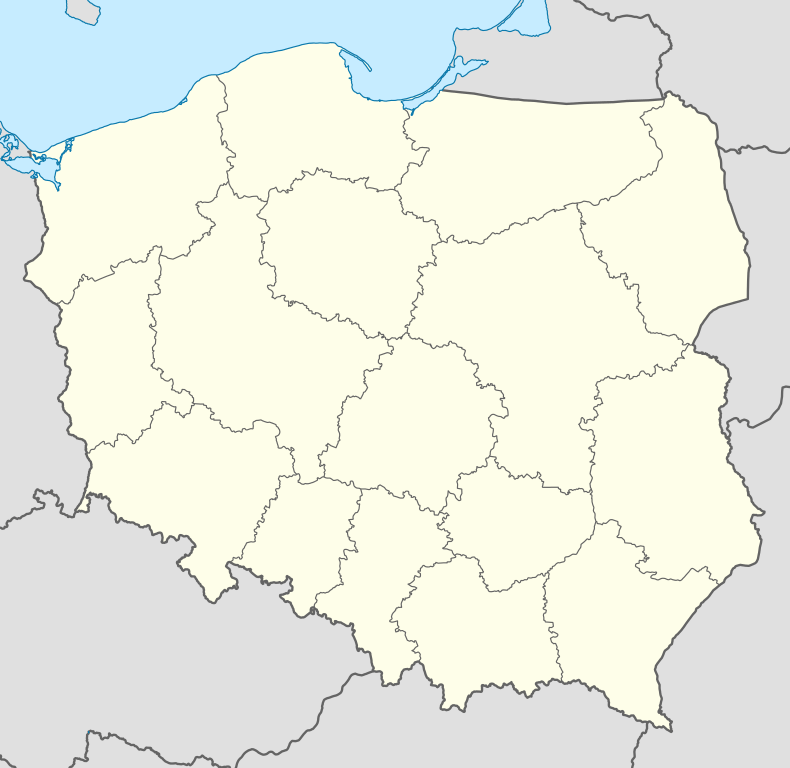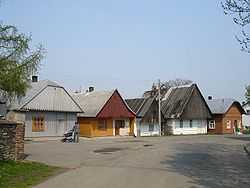Jaśliska
| Jaśliska | |
|---|---|
| Village | |
|
Old houses in Jaśliska | |
 Jaśliska | |
| Coordinates: 49°27′N 21°48′E / 49.450°N 21.800°E | |
| Country |
|
| Voivodeship | Subcarpathian |
| County | Krosno County |
| Gmina | Gmina Jaśliska |
| Population | 480 |
Jaśliska [jaˈɕlʲiska] (Ukrainian: Яслиська, Yaslys’ka) is a village in Krosno County, Subcarpathian Voivodeship, in south-eastern Poland, close to the border with Slovakia. It lies approximately 16 kilometres (10 mi) south-east of Dukla, 27 km (17 mi) south of Krosno, and 67 km (42 mi) south of the regional capital Rzeszów.[1]
The village has a population of 480. It gives its name to the protected area known as Jaśliska Landscape Park.
Since 1 January 2010, Jaśliska has been the seat of the gmina (administrative district) called Gmina Jaśliska, which was formerly part of Gmina Dukla. The village was previously the seat of a gmina in the periods 1934–1954 and 1973–1976.
In the early years of Polish statehood, the area of Jasliska probably belonged to the tribe of the Vistulans, which in the late 10th century became part of Poland. For the next centuries, this hilly corner of the kingdom was sparsely inhabited and covered by dense forests. In the mid-14th century, King Kazimierz Wielki decided to found a new town, located in the Jasiolka river valley. On January 28, 1366 in Opatowiec, the King granted Magdeburg rights to a town called Hohstadt (see Walddeutsche). First owner of the town was a Hungarian nobleman, John of Hanselin.
Hohstadt, whose name was later changed into Jasliska, had a vogt, and a medieval market square with a town hall, modelled after nearby Biecz. In the late 1360s, a man named Hank Weiss was named voght of Hohstadt, and in 1386 – 1389 the town with adjacent villages became property of Zyndram of Maszkowice, after whose death Hohstadt passed into royal hands. In 1431 King Wladyslaw Jagiello handed Hohstadt to Janusz, the Bishop of Przemysl. For the next 400 years, until 1848, Jasliska and a number of local villages, inhabited mostly by Rusyns, belonged to Bishops of Przemysl.
In 1474, the area of Jasliska was destroyed in a raid of Hungarian army of Matthias Corvinus. The town was burned to the ground, so on May 1, 1506 in Lublin, King Aleksander Jagiellonczyk granted additional privileges to Jasliska, including weekly fairs on every Tuesday, and extempting its residents from taxes for the period of eight years. In 1559, Jasliska was granted the right to stock wine in cellars, but at the same time, merchants bypassed the town, due to high duties.
Jasliska prospered in the period known as Polish Golden Age, when it belonged to Biecz County of Krakow Voivodeship. The town was located along a very busy merchant route from Poland to Hungarian-ruled Slovakia. On August 18, 1578, King Stefan Batory confirmed the privileges of Jasliska, stating that all wine merchants had to take the southward route via Jasliska, Dukla, Rymanow. In 1608, Bishop of Przemysl banned all non-Catholics from settling in the town.
In early 1656, Lesser Poland was invaded by Transilvanian army of George II Rakoczi (see also Swedish invasion of Poland. The enemy tried to capture Jasliska, but the town was well defended, and the Transilvanians abandoned the siege. To commemorate this success, a monument was erected in 1659.
In 1724-32, Bishop Aleksander Antoni Fredro funded a brick church in Jasliska. The complex was remodelled in 1912. In March 1762, Pope Clement XIV issued a bill, in which Jasliska was transferred from the Diocese of Krakow to the Diocese of Przemysl. In 1772, following the first partition of Poland, Jasliska was annexed by the Habsburg Empire, and remained in Austrian Galicia until 1918. During Austrian rule, Jasliska declined and lost its significance. Finally, in 1934, the government of the Second Polish Republic stripped it of the town charter.
See also
References
| Wikimedia Commons has media related to Jaśliska. |
| ||||||||||
